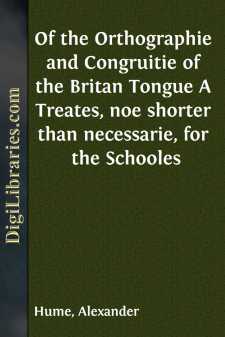Categories
- Antiques & Collectibles 13
- Architecture 36
- Art 48
- Bibles 22
- Biography & Autobiography 813
- Body, Mind & Spirit 141
- Business & Economics 28
- Children's Books 12
- Children's Fiction 9
- Computers 4
- Cooking 94
- Crafts & Hobbies 4
- Drama 346
- Education 46
- Family & Relationships 57
- Fiction 11826
- Games 19
- Gardening 17
- Health & Fitness 34
- History 1377
- House & Home 1
- Humor 147
- Juvenile Fiction 1873
- Juvenile Nonfiction 202
- Language Arts & Disciplines 88
- Law 16
- Literary Collections 686
- Literary Criticism 179
- Mathematics 13
- Medical 41
- Music 40
- Nature 179
- Non-Classifiable 1768
- Performing Arts 7
- Periodicals 1453
- Philosophy 64
- Photography 2
- Poetry 896
- Political Science 203
- Psychology 42
- Reference 154
- Religion 513
- Science 126
- Self-Help 83
- Social Science 81
- Sports & Recreation 34
- Study Aids 3
- Technology & Engineering 59
- Transportation 23
- Travel 463
- True Crime 29
Of the Orthographie and Congruitie of the Britan Tongue A Treates, noe shorter than necessarie, for the Schooles
by: Alexander Hume
Categories:
Description:
Excerpt
OF THE GROUNDES OF ORTHOGRAPHIE.
Cap. 1.
1. To wryte orthographicallie ther are to be considered the symbol, the thing symbolized, and their congruence. Geve me leave, gentle reader, in a new art, to borrow termes incident to the purpose, quhilk, being defyned, wil further understanding.
2. The symbol, then, I cal the written letter, quhilk representes to the eie the sound that the mouth sould utter.
3. The thing symbolized I cal the sound quhilk the mouth utteres quhen the eie sees the symbol.
4. The congruence between them I cal the instrument of the mouth, quhilk, when the eie sees the symbol, utteres the sound.
5. This is the ground of al orthographie, leading the wryter from the sound to the symbol, and the reader from the symbol to the sound. As, for exemple, if I wer to wryte God, the tuich of the midle of the tongue on the roofe of the mouth befoer the voual, and the top of the tongue on the teeth behind the voual, myndes me to wryte it g o d. The voual is judged be the sound, as shal be shaued hereafter. This is the hardest lesson in this treates, and may be called the key of orthographie.
OF THE LATINE VOUALES.
Cap. 2.
1. We, as almaest al Europ, borrow our symboles from the Romanes. Quherforr, to rectefie our aun, first it behoves us to knaw their’s. Thei are in number 23: a, b, c, d, e, f, g, h, i, k, l, m, n, o, p, q, r, s, t, u, x, y, and z.
2. To omit the needless questiones of their order and formes; of them, five be vouales, ane a noat of aspiration, and all the rest consonantes.
3. A voual is the symbol of a sound maed without the tuiches of the mouth.
4. They are distinguished the ane from the other be delating and contracting the mouth, and are a, e, i, o, u.
5. Quhat was the right roman sound of them is hard to judge, seeing now we heer nae romanes; and other nationes sound them after their aun idiomes, and the latine as they sound them.
6. But seeing our earand is with our aun britan, we purpose to omit curiosities, et quæ nihil nostra intersunt. Our aun, hou-be it dialectes of ane tong, differing in the sound of them, differ alsoe in pronuncing the latine. Quherfoer, to make a conformitie baeth in latine and English, we man begin with the latine.
7. A, the first of them, the south soundes as beath thei and we sound it in bare, nudus; and we, as beath thei and we sound it in bar, obex.
8. But without partialitie (for in this earand I have set my compas to the loadstar of reason), we pronunce it better. If I am heer deceaved, reason sall deceave me.
9. For we geve it alwaies ane sound beath befoer and behind the consonant: thei heer ane and ther an other. As in amabant, in the first tuae syllabes they sound it as it soundes in bare, and in the last as it sounds in bar. Quherupon I ground this argument. That is the better sound, not onelie of this, but alsoe of al other letteres, quhilk is alwayes ane. But we sound it alwayes ane, and therfoer better. Ad that their sound of it is not far unlyke the sheepes bae, quhilk the greek symbolizes be η not α, βη not βα....


